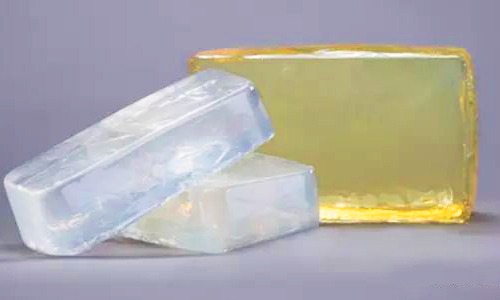
Hot Melt Adhesives (HMAs), a key category in the adhesive industry, are characterized by their 100% solid content, solvent-free composition, eco-friendliness, and rapid curing. These attributes make them indispensable in automated packaging, hygiene products, label and tape manufacturing, healthcare, automotive, construction, furniture, printing, footwear, and textiles. HMAs exist as solids at room temperature but melt into viscous liquids when heated. Upon application and cooling, they achieve bonding within seconds. In 2013, China's HMA industry reached a production value of ¥11.8 billion, with an output of 596,400 tons, marking it as the fastest-growing segment in the country's adhesive sector.
Hot melt pressure-sensitive adhesives (HMPSAs), a subset of HMAs, are synthesized from synthetic rubbers (e.g., SIS, SBS, SEBS) combined with tackifying resins, plasticizers, antioxidants, and other additives. These formulations are heat-processed into uniform melts and widely applied in label tapes, hygiene products, and packaging.
I. Technical Advantages of HMAs
Eco-Efficiency and High Performance
Zero VOC emissions: Compliance with regulations such as EU REACH eliminates flammability and pollution risks associated with solvent-based adhesives.
Ultrafast curing: 0.5–5 seconds, enabling high-speed coating (up to 300 m/min) to meet demands for thousands of labels per minute.
Tailorable Formulations
Base polymers: SIS (elasticity), SBS (rigidity), or SEBS (weather resistance) regulate tack, peel strength, and shear resistance through block copolymer design.
Tackifying resins: C5/C9 hydrocarbon or terpene resins (40–60% content) adjust viscosity-temperature profiles; hydrogenated resins enhance UV stability.
Functional additives: Nano-silica (0.5–2%) improves creep resistance; UV stabilizers mitigate outdoor degradation.
Process Adaptability
Viscosity range: 800–15,000 cP at 180°C, compatible with slot-die, roll, or spray coating, achieving precision up to ±0.1 g/m².
Low-temperature HMAs: Operate at 110–130°C, reducing energy consumption by 30% for heat-sensitive substrates like BOPP films.
II. Core Applications in Label and Tape Manufacturing
Pressure-Sensitive Label Systems
Permanent labels: Peel strength >10 N/25mm (ASTM D3330), using highly cross-linked SIS with 20–30% naphthenic oil for flexibility.
Removable labels: Balanced peel force (2–5 N/25mm) and residue-free removal via controlled resin compatibility (e.g., terpene-SBS blends).
Freezer-grade labels: Maintain adhesion at -40°C using low-Tg resins (e.g., hydrogenated C5, Tg < -50°C) and high-MW SEBS.
Specialty Tapes
Medical breathable tapes: Moisture permeability >1,000 g/m²/24h (ISO 15496), achieved via microsphere foaming (5–10% foaming agents).
Automotive wire harness tapes: Withstand 150°C (UL 746B) using SEBS/PP blends with phosphorus-based flame retardants.
Wash-off labels: Hydrophilic PEG-modified resins enable cold-water removal (contact angle <90°, GB/T 24368).
Smart Label Innovations
RFID encapsulation adhesives: Dielectric constant <2.8 (1MHz) via low-polarity SEPS/hydrogenated resin systems to ensure RF signal penetration.
Thermochromic labels: Integrate temperature-sensitive microcapsules (±2°C threshold) with low-thermal-conductivity adhesives (<0.2 W/m·K).
III. Industry Trends and Market Dynamics
Technological Advancements
Bio-based HMAs: Polylactic acid (PLA) hybrids reduce CO₂ emissions by 60% compared to petroleum-based HMAs.
Self-healing adhesives: Diels-Alder dynamic bonds restore 80% shear strength (60°C/2h).
Market Expansion
Global label HMA market: Valued at $2.8 billion in 2023 (Grand View Research), with China holding a 35% share.
E-commerce logistics: China's 110.5 billion parcels in 2022 drove demand for >150,000 tons of label adhesives annually.
Regulatory Compliance
FDA 21 CFR 175.105: Mandatory for food-contact labels.
EN 71-3: Limits heavy metals (<50 ppm) in toy safety labels.
IV. Future Outlook
HMA technology is evolving toward multifunctionality and intelligence. Breakthroughs in UV curing, biodegradability, and smart materials will unlock billion-dollar opportunities in flexible electronics and advanced packaging. To maintain competitiveness, industry leaders must prioritize:
Computational formulation design (materials genomics) for accelerated R&D.
Industry 4.0 integration: Digitized processes such as in-line viscosity control for precision manufacturing.
By aligning with sustainability goals and leveraging cutting-edge innovations, HMAs will continue to dominate as a critical enabler in the label and tape industry.
 HOT LINE: 086-577-65159218
HOT LINE: 086-577-65159218












